Teeth whitening and teeth bleaching are the two types of teeth brightening procedures. Although both aim for abrighter smile, they are different. If you are planning on having pearly white teeth, this article is for you.
What Causes Tooth Discoloration?
Many believe that their natural teeth should be bright and pearly white, while bright white teeth are not as common as you may think. Natural teeth come in a variety of shades, often sporting yellow or gray hues, and not bleached bright white.
Your teeth are made of two primary layers. The enamel is the hard surface layer that covers the supporting layer known as dentin. The dentin has a yellowish appearance. If your enamel is thin, the yellowish appearance will show through the enamel. As you age, your enamel also breaks down, causing the yellowish appearance to gradually appear with age.

Teeth Whitening
Teeth whitening involves restoring teeth to their natural color by removing stains with components that can be found in mouthwash and toothpaste. Unlike a bleaching procedure, whitening doesn’t aim to change your teeth' color beyond their natural color. Teeth whitening products contain mild abrasives or other substances that work to remove debris and food particles from the surface of your teeth.

The Pros of Laser Teeth Whitening
Only 2-4 sessions needed
Each session takes 15-60 minutes
You’re likely to see some results right away
Since it’s done under medical supervision, any negative reaction is minimized.
The Cons of Laser Teeth Whitening
A 10 to 14-day gap is required between each session, which could take 2 months to complete.
You have to watch your diet for the first 48 hours after a teeth whitening session. Eating colored food can re-stain the teeth during this sensitive period.
Some people learn their teeth are sensitive to the high concentration of peroxide used in laser whitening treatments, making the treatments potentially painful.
You are required to use bleaching trays that you must use with peroxide gel every day between your laser treatments.
Laser teeth whitening is very expensive.
Teeth Bleaching
The teeth bleaching process involves using hydrogen peroxide and carbamide peroxide which helps in chemically whitening the teeth and restoring them to a shade even whiter than their natural color. This enables the whitening agent to not only bleach any stains but also penetrate deeper into the enamel and the dentin, revealing a whiter shade than your natural tooth color. Typically, your dentist will give you a fitted bleaching tray, and you’ll sleep with it in place or wear it for 30 minutes to 2 hours. You continue this daily for anywhere from a few days to a few weeks, depending on how much bleaching your teeth need.

Pros of Teeth Bleaching
Individually created bleaching tray that matches your dental structure.
An easy process that can be done while you sleep.
Comfortable thin, clear bleaching trays.
Bleaching costs far, far less than laser whitening.
Cons of Teeth Bleaching
Bleaching requires more applications than laser teeth whitening.
Some aren’t comfortable using the bleaching trays or don’t want to wait a few weeks for results.
Which is better: Teeth Whitening or Teeth Bleaching?
Teeth whitening and teeth bleaching both aim to whiten teeth. Teeth whitening is a process that deals with the removal of stains caused due to smoking, coffee, and tea. On the other hand, teeth bleaching uses hydrogen peroxide to provide fast, safe, and long-lasting white teeth.
Conclusion
In conclusion, Teeth Whitening and Teeth Bleaching, while often used interchangeably, refer to two distinct processes in dental care. Teeth whitening typically involves the removal of surface stains to restore teeth to their natural shade. This process can be achieved with over-the-counter products and is effective for surface stains caused by substances like coffee, red wine, and tobacco. On the other hand, teeth bleaching goes a step further, using chemical agents like hydrogen peroxide or carbamide peroxide to lighten the color of the tooth enamel, sometimes beyond the teeth’s natural color. This process is often administered by dentists and can provide more dramatic results.